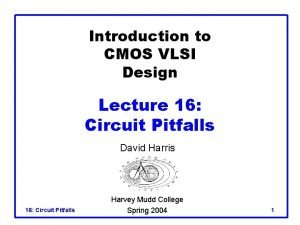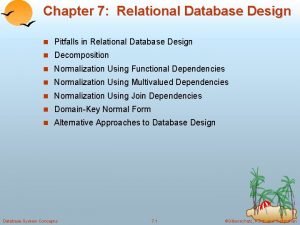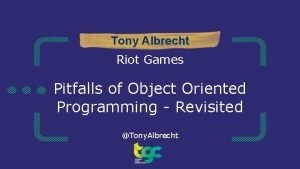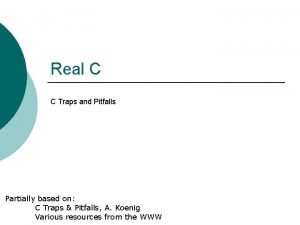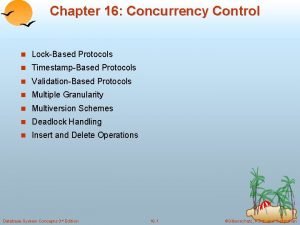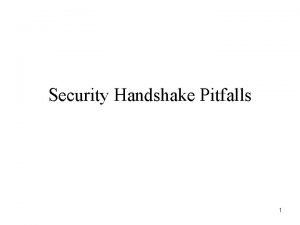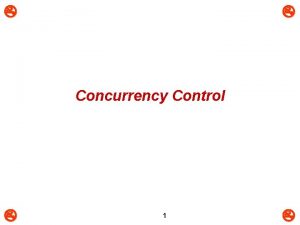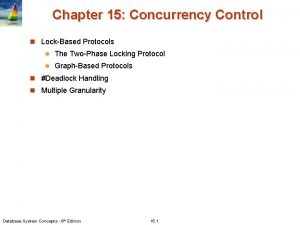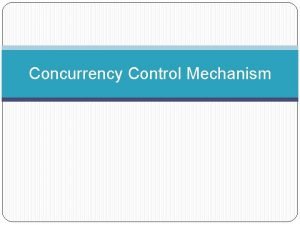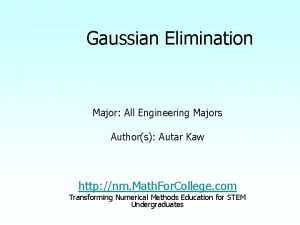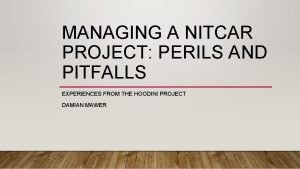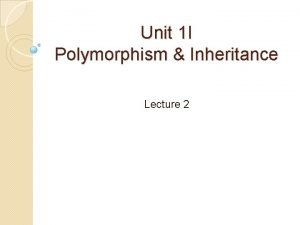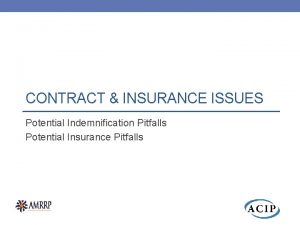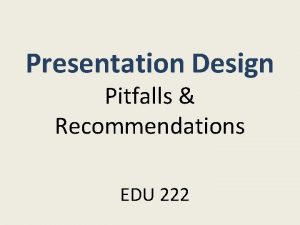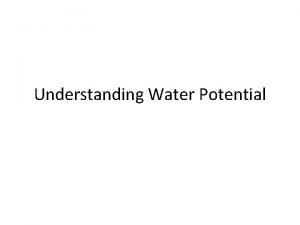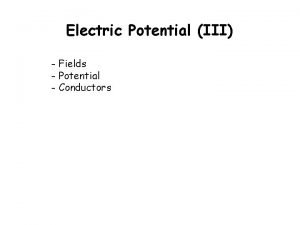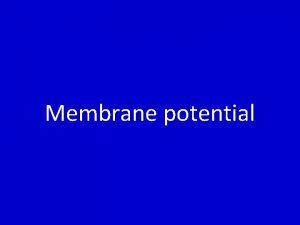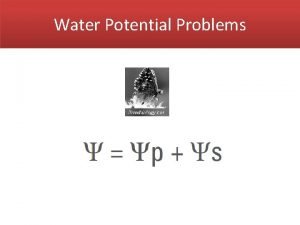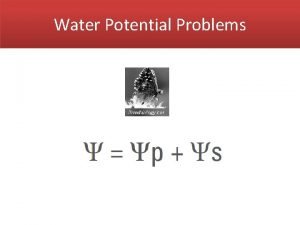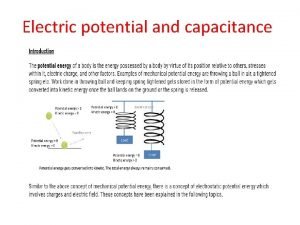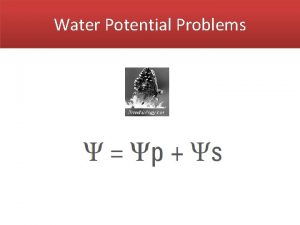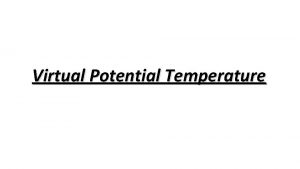Potential Pitfalls of the Message in Message Mechanism


































































- Slides: 66

Potential Pitfalls of the Message in Message Mechanism in Modern 802. 11 Networks Wei Wang, Wai Kay Leong, and Ben Leong School of Computing, National University of Singapore

Wi-Fi is Ubiquitous School of Computing 2

The Problem Message in Message Mechanism (Mi. M) MAC protocol ACK Interference Power Control School of Computing 3

What is Mi. M? MESSAGE IN MESSAGE MECHANISM School of Computing

Conventional Receiver w/o Mi. M Higher RSSI Frame B Frame A Time School of Computing 5

Reception of Conventional Receiver Both frames are lost Treated as noise RSSI Frame B corrupted CRC check fails Frame A Time School of Computing 6

Message in Message (Mi. M) Higher signal dominates weaker signal Successfully Received RSSI Frame B Frame A knocked Frame A out Time School of Computing 7

Mi. M is helpful 1. Salvaged otherwise lost frame Successfully Received RSSI Desired Frame B Discarded Frame A knocked out Interfering Frame Time School of Computing 8

Mi. M is helpful 1. Salvaged otherwise lost frame 2. Desired frame is lost Successfully Received RSSI Desired Frame Discarded Interfering Frame Time School of Computing 9

Mi. M is helpful, at least no harm 1. Salvaged otherwise lost frame 2. Desired frame is lost Successfully Received RSSI Interfering Frame Discarded Desired Frame Time School of Computing 10

However… Consider Aggregate MPDUs MAC Frames A-MPDU School of Computing 11

However… Consider A-MPDU RSSI Interfering frame A-MPDU Time School of Computing 12

However… Consider A-MPDU Without Mi. M RX: 3 Fail: 3 RSSI Interfering frame A-MPDU Time School of Computing 13

However… Consider A-MPDU Key Insight: Mi. M can be harmful Without Mi. M RX: 3 Fail: 3 With Mi. M RX: 1 Fail: 5 Worse: No Block ACK RSSI Interfering frame A-MPDU gets knocked out A-MPDU Time School of Computing 14

Why Use A-MPDU? • A-MPDU reduces TX overhead • Maximum A-MPDU size - 64 KB for 11 n (equivalent to 40+ frames) - 1 MB for 11 ac (600+ frames) • A tiny interfering frame (e. g. ACK) can destroy the whole A-MPDU School of Computing 15

How Bad is it? SOMETIMES GOOD, SOMETIMES BAD School of Computing

What Can We Do? HOW TO EFFECTIVELY USE MIM School of Computing

Our Contributions 1. How bad is it? A: Study the impact of Mi. M on A-MPDUs 2. What can we do? A: Adaptive algorithm to enable/disable Mi. M School of Computing 18

Studying the Impact of Mi. M Experimental set-up Sender Receiver Interferer ◦ Sender & Interferer out-of-range ◦ Receiver closer to Interferer School of Computing 19

Studying the Impact of Mi. M Experimental set-up A-MPDU Interfering Frame Receiver Sender Interferer ◦ Sender & Interferer out-of-range ◦ Receiver closer to Interferer ◦ Sender sends an A-MPDU (w/o MAC retry) ◦ Interferer broadcast an Interfering Frame School of Computing 20

Studying the Impact of Mi. M Experimental set-up A-MPDU Interfering Frame Receiver Sender Interferer ◦ Sender & Interferer out-of-range ◦ Receiver closer to Interferer ◦ Sender sends an A-MPDU (w/o MAC retry) ◦ Interferer broadcast an Interfering Frame ◦ Measure FDR School of Computing 21

Ensure collision Immediately Tx A-MPDU Sender Receiver Interferer Poll t Interfering Frame t is uniformly distributed School of Computing Time 22

Duration of A-MPDU Max duration limited by ath 9 k driver A-MPDU ≈ 3. 8 ms School of Computing Max. 4 ms Time 23

Size of A-MPDU (# frames) Depends on data rate 26 Mbps 8 frames 6. 5 Mbps 2 frames Max. 4 ms A-MPDU Time ≈ 3. 8 ms MCS Index 0 1 2 3 4 5 6 7 Data Rate (Mbps) 6. 5 13 19. 5 26 39 52 58. 5 65 Frames 2 4 6 8 12 16 18 20 School of Computing 24

The Detrimental Impact of Mi. M 1. Size of A-MPDU ◦ # Frames per A-MPDU 2. Length of Interference Frame ◦ Air-time duration 3. Channel Bonding ◦ Using adjacent channels School of Computing 26

1. Size of A-MPDU? NUMBER OF FRAMES IN AN A-MPDU School of Computing

Impact of A-MPDU size A-MPDU of 2 frames Interfering Frame 60 μs ≈ 3. 8 ms Time 0. 5 School of Computing 28

Impact of A-MPDU size A-MPDU of 4 frames Interfering Frame 60 μs Time ≈ 3. 8 ms School of Computing 29

Impact of A-MPDU size A-MPDU of 4 frames 0. 25 School of Computing 30

Impact of A-MPDU size A-MPDU of 20 frames Interfering Frame 60 μs ≈ 3. 8 ms Time More details in the paper School of Computing 31

Frame Delivery Ratio Interfering Frame 60 μs ≈ 3. 8 ms School of Computing Time 32

Frame Delivery Ratio Interfering Frame 600 60 μsμs ≈ 3. 8 ms Time 0. 9 0. 5 School of Computing 33

Frame Delivery Ratio Interfering Frame 600 μs Time ≈ 3. 8 ms 0. 5 School of Computing 34

2. Length of Interference Frame THE AIR-TIME DURATION School of Computing

Air-time of Interfering Frames T Time ≈ 3. 8 ms Intuition: Without Mi. M, longer T more frames loss With Mi. M, T has no effect School of Computing 36

How to set T T Time ≈ 3. 8 ms 1. Vary frame length (# of bytes) 2. Vary data rate (bytes per sec) School of Computing 37

Increasing Frame Length School of Computing 38

Increasing Frame Length School of Computing 39

Increasing Frame Length School of Computing 40

Increasing Data Rate Air-time duration is what matters School of Computing 41

Air-time Duration… in the Wild School of Computing 42

Air-time Duration… in the Wild 170 μs IPv 6 Neighbor Discovery Protocol Median ≈ 30 μs 20 μs MAC ACK School of Computing 43

Putting it in Perspective Be careful what you choose Suffer a large penalty in the wild School of Computing 44

3. Channel Bonding USING ADJACENT CHANNELS School of Computing

Channel bonding Sender Receiver Interferer 20 MHz 40 MHz School of Computing 50

Channel bonding: Case 1 Sender Receiver Interferer School of Computing 51

Channel bonding: Case 2 Sender Receiver Interferer School of Computing 52

Channel bonding: Case 3 Sender Receiver Interferer School of Computing 53

Channel bonding: Case 4 Sender Receiver Interferer School of Computing 54

Channel bonding: Case 5 Sender Receiver Interferer School of Computing 55

Channel bonding Case 1 Sender Receiver Interferer Sender Case 2 Case 3 Receiver Interferer Sender Receiver Interferer Case 4 Sender ≡ Sender Receiver Interferer Case 5 Sender Receiver Interferer School of Computing 56

Adjacent Channel Interference Sender Receiver Interferer School of Computing 58

Adjacent Channel Interference 10 d. B Threshold Sender Receiver Interferer Lesser Interference School of Computing More Interference 59

Adjacent Channel Interference Sender Receiver Interferer School of Computing 60

Adjacent Channel Interference Sender Receiver Interferer School of Computing 61

Adjacent Channel Interference Sender Receiver Interferer School of Computing 62

Adaptive Mi. M DECIDING WHEN TO ENABLE/DISABLE MIM School of Computing

Some Definitions Good Knock-out Successfully Received RSSI Desired Frame Discarded Frame A knocked out Interfering Frame Time Bad Knock-out Discarded RSSI Interfering Frame Discarded Desired Frame Time School of Computing 64

Key Idea Count Good KO and Bad KO Compare Good > Bad No Disable Mi. M* Yes Enable Mi. M School of Computing Periodically *CATCH Cannot count with Mi. M disabled 65

Evaluation Experimental Set-up Campus AP Interferer Position 2 Equal signal strength Sender Position 3 Position 1 Desired signal is stronger School of Computing Campus AP Interference is stronger 66

Results w/o Adaptive Mi. M Sender > Interferer Mi. M helpful School of Computing Sender = Interferer Mi. M neutral Sender < Interferer Mi. M detrimental 67

Results with Adaptive Mi. M always useful Sender > Interferer Mi. M helpful School of Computing Sender = Interferer Mi. M neutral Sender < Interferer Mi. M detrimental 68

In Conclusion Mi. M not always helpful, can be harmful 1. Studied harmful effect of Mi. M ◦ ◦ ◦ on A-MPDUs 10 d. B threshold Adjacent Channels 2. Adaptive Mi. M Algorithm ◦ ◦ Use Mi. M only when good Near optimal results School of Computing 69

Future Work 1. Update the 802. 11 MAC/PHY implementation in simulators like ns-3 2. Analytically model the effect of Mi. M on AMPDU 3. Develop algorithm to dynamically adjust AMPDU size School of Computing 70

Thank You QUESTIONS? {weiwang| waikay|be nleong}@comp. nus. edu. sg School of Computing

FAQ School of Computing 72
 Adm decide model
Adm decide model Circuit pitfalls in vlsi
Circuit pitfalls in vlsi Decision making pitfalls
Decision making pitfalls What is pitfalls in relational database design
What is pitfalls in relational database design Circuit pitfalls in vlsi
Circuit pitfalls in vlsi Pitfalls of object oriented programming
Pitfalls of object oriented programming Pitfalls in differentiation
Pitfalls in differentiation C traps and pitfalls
C traps and pitfalls What is lock based protocol in dbms
What is lock based protocol in dbms Pitfalls in selecting new ventures
Pitfalls in selecting new ventures Security handshake pitfalls
Security handshake pitfalls What are two pitfalls (problems) of lock-based protocols
What are two pitfalls (problems) of lock-based protocols The pitfalls of a differentiation strategy include
The pitfalls of a differentiation strategy include What are two pitfalls (problems) of lock-based protocols
What are two pitfalls (problems) of lock-based protocols Concurrency control mechanisms
Concurrency control mechanisms The goal of forward elimination steps in the na
The goal of forward elimination steps in the na Pitfalls adalah
Pitfalls adalah The perils and pitfalls of leading change case solution
The perils and pitfalls of leading change case solution Pitfalls of prototyping
Pitfalls of prototyping Pitfalls of operator overloading in c++
Pitfalls of operator overloading in c++ Electric potential and potential energy
Electric potential and potential energy Action potential resting potential
Action potential resting potential Neuronal pool
Neuronal pool Electric potential inside non conducting sphere
Electric potential inside non conducting sphere Saltatory conduction
Saltatory conduction Transmission across a synapse
Transmission across a synapse Osmotic potential vs water potential
Osmotic potential vs water potential Electric potential
Electric potential Market potential and forecasting
Market potential and forecasting Nerve action potential
Nerve action potential Define electrical potential difference
Define electrical potential difference Rocuronium dose
Rocuronium dose How to find pressure potential
How to find pressure potential What is water potential
What is water potential Equipotential lines
Equipotential lines Characteristics of graded potential
Characteristics of graded potential Electric potential from electric field
Electric potential from electric field Axon hillock
Axon hillock Source of bioelectric potential is
Source of bioelectric potential is How to calculate solute potential
How to calculate solute potential Electric potential energy
Electric potential energy Graded potential vs action potential
Graded potential vs action potential Một số thể thơ truyền thống
Một số thể thơ truyền thống Các châu lục và đại dương trên thế giới
Các châu lục và đại dương trên thế giới Thế nào là hệ số cao nhất
Thế nào là hệ số cao nhất Sơ đồ cơ thể người
Sơ đồ cơ thể người Tư thế ngồi viết
Tư thế ngồi viết đặc điểm cơ thể của người tối cổ
đặc điểm cơ thể của người tối cổ Cách giải mật thư tọa độ
Cách giải mật thư tọa độ Tư thế worms-breton
Tư thế worms-breton Bổ thể
Bổ thể ưu thế lai là gì
ưu thế lai là gì Thẻ vin
Thẻ vin Cái miệng nó xinh thế chỉ nói điều hay thôi
Cái miệng nó xinh thế chỉ nói điều hay thôi Thơ thất ngôn tứ tuyệt đường luật
Thơ thất ngôn tứ tuyệt đường luật Các châu lục và đại dương trên thế giới
Các châu lục và đại dương trên thế giới Từ ngữ thể hiện lòng nhân hậu
Từ ngữ thể hiện lòng nhân hậu Tư thế ngồi viết
Tư thế ngồi viết Diễn thế sinh thái là
Diễn thế sinh thái là Ví dụ giọng cùng tên
Ví dụ giọng cùng tên 101012 bằng
101012 bằng Bài hát chúa yêu trần thế alleluia
Bài hát chúa yêu trần thế alleluia Hổ đẻ mỗi lứa mấy con
Hổ đẻ mỗi lứa mấy con đại từ thay thế
đại từ thay thế Vẽ hình chiếu vuông góc của vật thể sau
Vẽ hình chiếu vuông góc của vật thể sau Quá trình desamine hóa có thể tạo ra
Quá trình desamine hóa có thể tạo ra Công thức tiính động năng
Công thức tiính động năng

